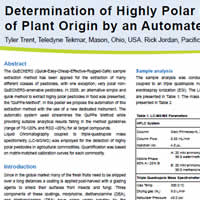Resumo do Pôster:
1. Introduction
Since in the global market many of the fresh fruits need to be shipped over a long distances a coating is applied post-harvest with a glazing agents to shield their surfaces from insects and fungi. Three components of these coatings, morpholine, diethanolamine (DEA), and triethanolamine (TEA) have come under scrutiny by the European Union (EU) due to the toxicological concerns with these compounds inherent tendency to oxidize to nitroso compounds which are known carcinogens.1 Currently there is a validated method for the analysis of numerous highly polar pesticides in foods of plant origin via LC-MS/MS involving simultaneous extraction with methanol (QuPPe-Method).2
The aim of this work is to evaluate the performance and versatility of an automatic system for the extraction of highly polar compounds using the QuPPe-Method M7 to determine morpholine, DEA, and TEA residues in fruits.2 Liquid Chromatography coupled to a triple-quadrupole mass spectrometry (LC-MS/MS) was used to analyze the samples prepared with the automatic system.
2. Purpose
Evaluate the performance and versatility of an automatic system for the extraction of highly polar pesticides using the QuPPe Method.
3. Method
Apple and orange samples were milled to reduce particle size and improve homogeneity. The samples were then stored at -20 ?C until the samples were extracted. Figure 1 shows the sample extraction steps that are needed to extract morpholine, DEA, and TEA residues from apples and oranges. The steps allways manually performed were the sample weighing and the transfering of the extract.
Sample analysis was conducted using a HPLC system coupled to a tandem mass spectrometer (MS/MS). Some method parameters and the mass transitions for each analyte are presented in Table 1 and 2 respectively. Quantification was based on matrix-matched calibration curves for apples and oranges. QC samples were evaluated at levels of 0.01, 0.05 and 0.1 mg/kg to ensure the precision and accuracy of the automatic system.
Table 1. LC-MS/MS Parameters |
Column |
Sielc Primesep-A, 2.1 mm x 100mm, 5μm (HILIC) |
Column Flow |
0.55 mL/min |
Injection Vol. |
4.0 µL |
Mobile Phase
80% A - 20% B |
A: 20mM Ammonium formate, 0.1% formic acid in 95:5 water/methanol
B: 20mM Ammonium formate, 0.1% formic acid in 95:5 methanol/water |
Table 2. MS/MS Acquired Mass Transitions (m/z) |
Compound |
Precursor Ion |
Quantization Product Ion |
Confirmation Product Ion |
Morpholine |
88.1 |
70.1 |
44.0 |
Diethanolamine |
106.0 |
70.0 |
45.0 |
Triethanolamine |
150.0 |
70.0 |
132.0 |
4. Results and Discussion
A precision and accuracy study was performed using the automated system to extract highly polar residues from apples and oranges. The system was able to fortify the apple and orange samples at 0.01, 0.05, and 0.10 mg/kg using the instrumet's ability to make standard additions. The recoveries ranged from 70% to 116% and the precision from 1.72% to 14.29%. All control samples used for this study showed no significant residue for the apple samples but there was TEA present in the orange samples, so no validation was performed in the orange for TEA.
5. Conclusion
Automation of the QuPPe extraction method produced reliable results for the spiked samples, which compared favorably with those from the existing manual procedure. Precision and accuracy were assessed for the two commodities analyzed. Results for the automated procedure were well within the criteria set forth in this study: Average recoveries for the range of commodities were between 70.0% and 116.0% with good precision (ca. 6% RSD).
6. References
- Elizabeth A. Baldwin, Robert Hagenmaier and Jinhe Bai. Edible coatings and films to improve food quality. 2012, Taylor & Francis Group, LLC, 2nd Edition.
- M. Anastassiades, et al. Quick Method for the Analysis of numerous Highly Polar Pesticides in Foods of Plant Origin via LC-MS/MS involving Simultaneous Extraction with Methanol (QuPPe-Method). EU Reference Laboratory, Single Residue Methods - Version 8.1 (March 2015). Method 7 “Morpholine, Diethanolamine and Triethanolamine”.
|

